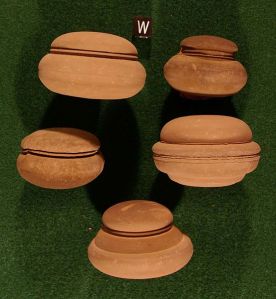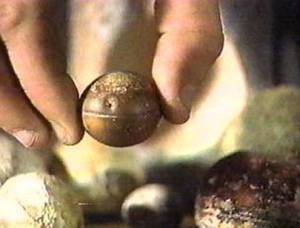I’ve seen this article several times now, and I meant to address it the first time, but then I got distracted by something shiny…er I mean work?
Either way, the biggest reason I let it go was that I wasn’t terribly concerned about it. I mean, these things are so obviously geofacts or frauds, who in their right mind would believe them? Then I saw this same article come across my feed on Linked-In, it kinda made me sad. So, to make myself feel better, I will explain why these 10 ‘puzzling’ artifacts are not so puzzling after all.
Sadly, as with a lot of things, it’s easy to put a lie or misinformation out there, it’s twice as difficult to explain why they are wrong. So we’ll be looking at each of these “artifacts” one at a time. Starting with:
The Grooved Spheres

There is a phenomenon in the human brain called Pareidolia. This particular event is what causes us to see shapes in the clouds, faces on trees, and the Virgin Mary on toast. What’s that got to do with grooved spheres you ask? Well, the long and short of it is, Pareidolia is a fancy way of saying, we see what we want to see, and the people hyping the Grooved Spheres want to see what isn’t there.
Those who I would not describe as experts want these stones to be something otherworldly, something strange, and inexplicable. The problem is that experts have explained them, and they are rather worldly, but still cool.
The major claims about the Spheres is that they are perfectly spherical [1], grooved [1], made of metal [1], are harder than steel [2], rotate on their axis [2], sing the theme from Star Trek, and are rather boss DJ’s…Ok I made the last two up, just in case you can’t tell.
The glaring problem with most of these claims is, as usual, the lack of evidence to back them up. Not to mention there only seems to be a few ‘sources’ that just get repeated over and over again, without being fact-checked. One of which is the ever creative Weekly World News [2].
When you ask actual Geologists about these ‘puzzling’ Spheres, you get some very un-puzzling answers.
These were pretty much debunked in 1996 [3] by Paul V. Heinrich, a research associate at the University of Louisiana. He did some extensive research into the Spheres, analyzing their structures, and even cutting a few in half. He found the Spheres to be completely natural. Lets looks at what he found.
Lets start with what the Spheres are actually made of; they consist either of hematite (Fe2O3), or wollastonite (CaSiO3) mixed with minor amounts of hematite and goethite (FeOOH) [2]. The Spheres found in unaltered pyrophyllite(Al2Si4O10(OH)2) consist of pyrite (FeS2) [2].
Geologists agree that these little Spheres are actually concretions formed in either volcanic sediments, ash, or both [2]. What causes the groves, simply put, is the formation process itself. The material the concretion forms in is softer than the concretion, and so when the softer material erodes away, all that’s left is the imprint it made.
For example, think of making a sand-mold candle. If you’ve never done this before let me explain. To make a sand candle the first thing you do is find some wet sand, like you would on the beach, or in a kid’s sand box. Then you press a shape into the sand, which is why it needs to be wet so it will hold it’s form. Next you pour melted wax into the mold you formed in the sand, add a wick, and let the wax harden. After the wax is all hard, you scoop it out of the sand, brush off the excess, and depending on your artistic ability, you have a lovely molded candle!
Let me tie this together for you, what you just did with the candle is similar to what happens when concretions form. When you poured the wax into the mold, the wet sand was the more stable, harder structure. Once the wax hardened, the reverse was true. But because the wax was hardening inside the sand, the sand left an imprint of itself on the wax. You’ll notice on your lovely new candle that on top of the shape you intentionally made, there are lots of little bits of sand stuck in the wax. When you brush those off they will leave behind cavities in the wax. This is how the groves in the stones formed.
It really is that simple, and that cool. The Grooved Spheres are quite natural, but the formation process it takes to form them is very interesting and the end product is obviously very cool to look at.

As can be seen, these are hardly 'perfect' spheres. W block is 1 cm squared for scale.
Also, since this is a natural process, the Spheres are hardly perfectly spherical. This is evident in the pictures of the Spheres themselves. They are spherical in nature, round and grooved, but not perfectly. So there goes that claim, debunked by the pictures offered by the people making the claim.

None of these are 'perfectly' spherical. W block is 1 cm square used for scale.
So, we know what the Spheres are made of, we know how they are made, and we know what they look like…let’s adress the more fantastical claim that they rotate all by themselves on an axis.
This one is perhaps the quickest bit to debunk, it seems the whole rotation thing is from a misquote from Roelf Marx, the former curator of the Klerksdorp Museum. He reports that he was misquoted in regards to these objects when he was interviewed [3]. The fabricated quote has Marx saying that the objects rotated by themselves in vibration-free display cases in the Klerksdorp Museum. Rather, Marx stated that they rotated precisely because of the numerous earth tremors generated by underground blasting in local gold mining [3].
Similar claims about NASA’s bafflement over the Spheres are likewise unsupported [2].

This one looks like the Death Star. That proves something right?
So it seems none of the puzzling claims about the Spheres hold any water, but this article continues to make the rounds every so often. Why? More importantly, why do people give it credence?
The first glaring problem with the article is that it’s on multiple websites, all of them conspiracy type sites, and not one of them offer an author for the article. The second issue is, nothing that is in the article is backed up by citation, even if it’s a crappy source, cite your work people!
I think the third issue here is most people don’t know what a well researched, well written article looks like these days. I will blame the internet for this and a very lazy media. So I make this plea to the internet population, please don’t assume that an article is full of facts just because it’s on the I-net! Be critical, look for sources, look for citation, ask yourself if the article backs up its claims with equivalent evidence.
I’ve laid out for you here why the Grooved spheres are natural , really cool, and unique occurrences, but natural all the same. These aregeofacts , natural occurring mineral objects that are often confused for being man made. Why? Because of good old fashion Pareidolia.
[1] “The 10 Most Puzzling Ancient Artifacts.”http://www.ancientx.com/nm/anmviewer.asp?a=75. Accessed April 2 2012.
[2] “Klerksdorp sphere.” http://en.wikipedia.org/wiki/Klerksdorp_sphere#cite_note-Cairncross1988-6. Accessed April 2 2012.
[3] 1996. Heinrich, Paul. ”The Mysterious Origins of Man: The South African Grooved Sphere Controversy.” http://www.talkorigins.org/faqs/mom/spheres.html. Accessed April 2 2012.




Comments